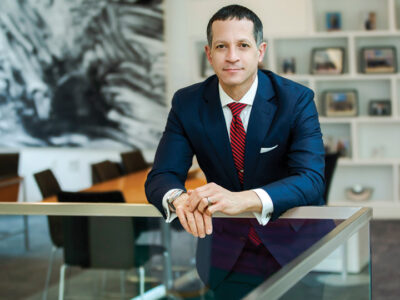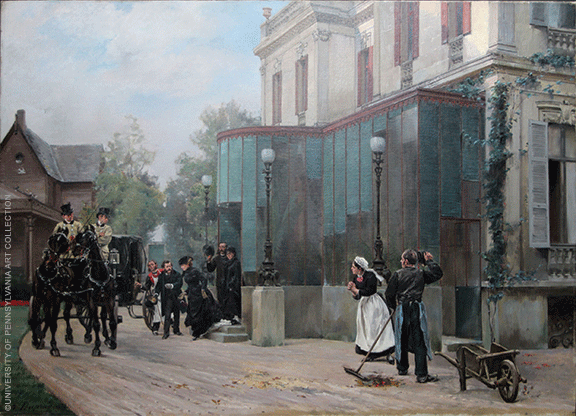
Escape Artistry: “Incognito Departure of Empress Eungénie,” Henri-Louis Dupray, 1884.
In a sense, Courtly Treasures: The Collection of Thomas W. Evans is the most glamorous and artful example of foren sic dental work ever. No, it didn’t involve examining cadaverous molars or checking the crowns of the unidentified deceased against their X-rays. But considering the work that went into locating, assembling, and restoring the dazzling trove of artwork and objets d’art that Evans collected during his years as surgeon dentist to the Emperor Napoleon III and the Empress Eugénie of France, the forensic image isn’t that much of a stretch. (For the full story on Evans, see “Crowns & Confidences,” Nov|Dec 1999.)
The exhibition, which opened at the Arthur Ross Gallery in July and runs through November 8, is largely the work of Denis Kinane, the Morton Amsterdam Dean of the School of Dental Medicine, and Lynn Marsden-Atlass, the Ross Gallery’s director and the University curator, with ample contributions by others, including Heather Gibson Moqtaderi, the collections manager and associate curator. It offers a rich array of paintings, sculpture, photographs, tankards, jewel boxes, and other items—more than 135 pieces in all.
“We’re focusing on trying to revive the glory that was the Penn Evans collection,” says Kinane. “I think we’re getting to that point now.”
Fittingly, the exhibition has been mounted in the centennial year of the Thomas W. Evans Museum and Dental Institute School of Dentistry University of Pennsylvania (as it was officially named in the wake of a legal compromise with the Evans estate). But the current chapter of the Evans story began shortly after Kinane became dean of the dental school in 2009.
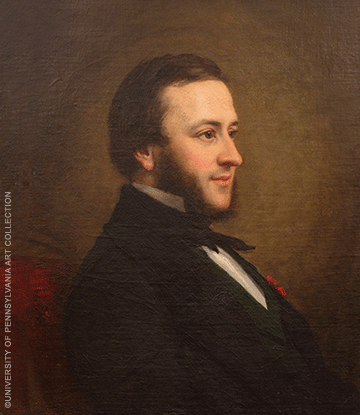
“Thomas W. Evans,” George Peter Alexander Healy, 1853.
Though he already knew a little about Evans and his collection when he took office, the Scottish-born Kinane quickly became absorbed in both—as well as in the collection’s unfortunate dispersal. It had been housed in the Evans Museum until 1967, when that part of the building was transformed into an emergency dental clinic, at which point most of the collection was consigned to storage facilities. After Walter Cohen D’50 became dean in 1972, he visited the Philadelphia warehouse in question and found, among other things, two paintings and a lithograph by Edouard Manet (who had shared a mistress with Evans and sold him several works). Those paintings, as well as some jewelry and other valuable items, were sold through auction, and the funds used to bolster the dental school’s endowment. The rest stayed in storage. But there were still bits and pieces of the collection in the Evans building, even if some were in frightful condition.
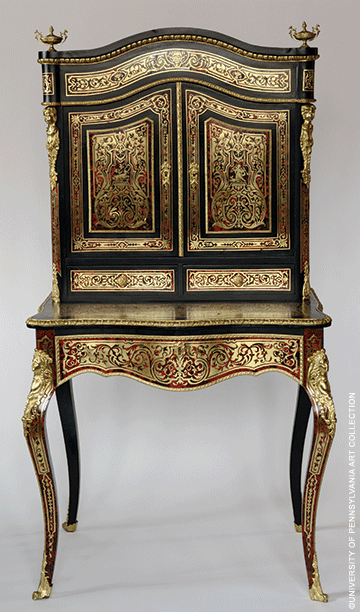
Boulle Secretary Desk, 19th century, France.
“I went to the basement and discovered a desk that had actually been in the office of Thomas Evans in Paris,” says Kinane, referring to the ornate, inlaid boulle secretary desk. “It was covered with old carpets and had legs missing and a variety of issues. When I first started discussing restoration, people were looking at me like I had two heads.
“To be frank, it was a little source of surprise that nothing had been done more substantively to maintain and preserve all of this history and all of this artwork,” he adds. Although some Penn Dental faculty and alumni have been supportive, it “wasn’t until I caught up with Lynn Marsden-Atlass and expressed to her my concern about the paintings that had basically disappeared and been scattered all around” that things began to change.
“Denis called me up out of the blue and said, ‘I’m the new dean of the dental school, and I’m a Scotsman, and [the school’s] patrimony is sort of in storage,’” recalls Marsden-Atlass in an interview.
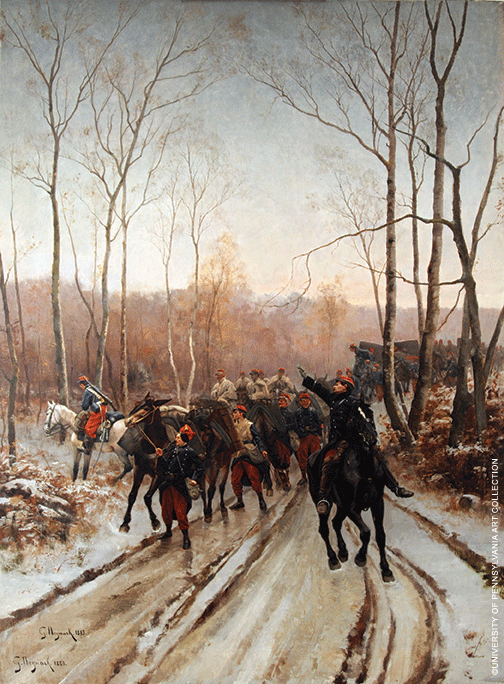
“Alert to the Rearguard,” Gustave Mardoche Neymark, 1883.
In an essay for the show’s catalogue, she notes that when she went to his office, “he showed me two nineteenth-century French paintings—one a portrait of Napoleon I, and the other a military scene. He drew from a case an ornately embellished sword and two muskets. On his desk he placed an oversized tankard.” All of those objects had been in an offsite storage warehouse, and the dean “was eager to unearth more of this overlooked cache of art and return it to the halls of the school,” she recounts. “Forgotten art treasure? I was hooked.”
The process of transferring the Evans pieces in storage to Van Pelt Library’s offsite warehouse in New Jersey and unpacking them was a “dirty job,” writes Marsden-Atlass. “Sadly, we discovered that most of the art works were broken, torn, or required extensive conservation, an enormous undertaking that would require a generous benefactor.” Kinane and the dental school, she notes, have supported the preservation work in many ways, and after six months of intensive “digitizing, documenting, and prioritizing the collection for conservation, the first three paintings and frames from the Evans Collection were sent out for conservation.” They returned “transformed,” she adds. “Since then, ongoing conservation has continued for paintings, sculpture, decorative arts, and furniture.”
The single most dramatic piece in the collection is the carriage that Evans used in 1870 to spirit the Empress Eugénie out of Paris and eventually to England, quite possibly saving her life from an angry Parisian mob. (For more on that, see “Window.”) That carriage, brought back from the Château de Compiègne near Paris (where it was on extended loan to the Réunion des Musées Nationaux), has been restored by Amish craftsmen (out of the Kinane family’s pocket) and is now in the dental school’s Schattner Center. The exhibition also features a large oil painting, Henri-Louis Dupray’s 1884 “Departure of Empress Eugénie,” which depicts the mutton-chopped Evans helping the empress into his carriage at the outset of their journey from Paris. But apart from the historically interesting oil portraits, photographs, busts, and reliefs of Evans et al, the real interest of the Courtly Treasures is the opulent gifts presented to Evans by the crowned heads of Europe.
“Nearly five years later, we can proudly say that most of the Thomas W. Evans Collection has been brought back to life,” Marsden-Atlass notes in her essay, and for the first time in 48 years, “one can catch a glimpse of the charmed life of ‘handsome Tom’ Evans. It is dazzling.” —S.H.




